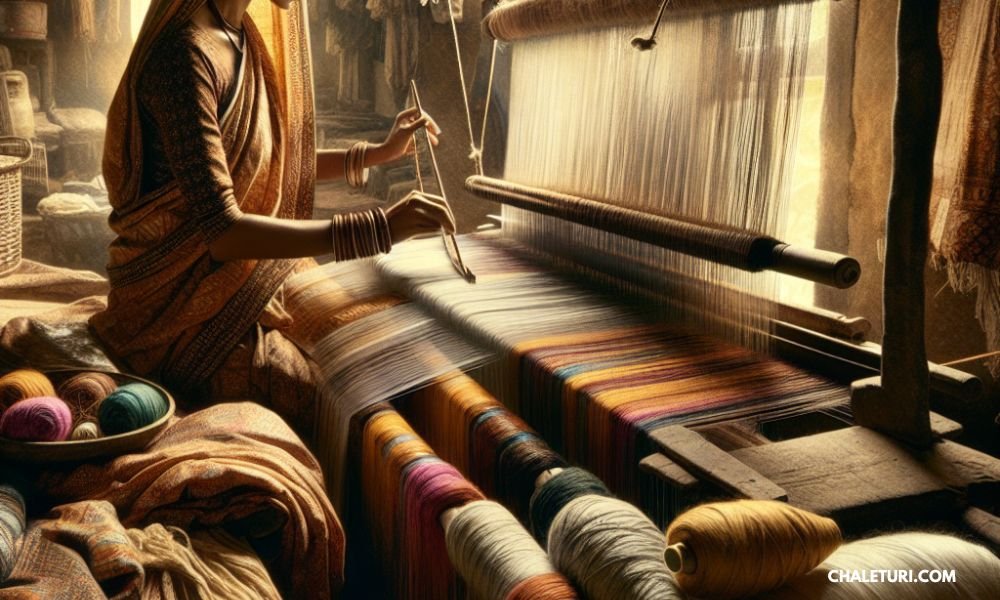As we live in a world filled with ever-changing fashion trends, there is a unique charm in the art of Tissariss, which does not go out of fashion. Future Tissariss customers who love fashion and are looking for more cultural and traditional art will find a catalog of stories in Tissariss. Thus, in this blog post, the author presents Tissariss in all its glory, revealing the legacy of a weaving practice linking past and present.
The Essence of Tissariss
Tissariss is more than a weaving technique; it is a narrative. Commonly associated with ancient civilizations that have a rich tradition in textile production, this technique creates narratives from threads. Each of the designs tells a story about the people that made them, their cultures, or historical episodes. In the case of fashion lovers, it is delving into the details of Tissariss and appreciating its embedded meanings.
In these times, adhering to traditional crafts like Tissariss is even more critical. It contributes to the protection of cultural values and gives the creators a chance to create for the sake of making a hand and earning a living. When everything is mass-made and designer cut, it is the handmade traditional crafts that save the sanity and reveal the market with the personality.
Discovering Tissariss
For us to understand Tissariss, we must first know what it is. For those unfamiliar with the term, emissaries is a weaving technique with complex patterns and bright colors. It is a technique of weaving decorative designs through patterned threads that describe the cultural aspects of the people. This technique is not merely a way of producing beautiful pieces of fabric but a method of preserving a culture of artistry.
It is about the Tissariss, which curls simple threads into complex tales of various cultures and histories. Even folk art will have a corresponding piece depicting the story behind it, and such is the nature of every artwork piece. Fashion fans practicing Tissariss activities are welcome to look for those stories and meet the hiders behind them.
Tracing the Historical Origins
Relatives of Tissariss are traces from ancient textile civilizations. Most likely, it speaks of the antique weaving centers, where it was of great cultural and economic value. Over the centuries, Tissariss has been developed, adapting to new epochs within which the main essence of the brand has been loyally retained.
It is worth noting the specific aspect of Tissariss’ evolution—its adaptation. If once Tissariss was made as the only local product, now it is a global product, broadening people’s views without the temptation to follow changing fashion. Such a twist has made it a beautiful art and worthwhile even generation after generation.
Mastering Weaving Techniques
Surrounded by various skills, the content of Tissariss remains at the crossroads of the business of weaving old techniques. When skilled professionals create fabrics, they utilize hand weaving, knotting, and braiding methods, which result in beautiful and strong fabrics. Such techniques require much attention and care; hence, the masterpieces are well appreciated.
Tissariss’s trademark remains hand-looming. Rather than letting machines produce the goods, each is a work of art in its own right constructed without the use of any equipment, thus allowing the craftsman to incorporate electronics in each of the works. To further beautify the designs, knotting and braiding are incorporated.
Tissariss has remained caught up in time. All this continues to breathe new life into this traditional form of art. Designers and artisans exploring other materials and techniques, old and new, helped make such pieces that would appeal to stylish individualists today.
The Beauty of Materials and Dyes
Tissariss has been known to incorporate cotton, silk, and wool. These materials are selected based on their strength, comfort, and best adhesion. Material selection affects the quality and beauty of Tissariss textiles.
The art of Tissariss is complete with the application of plant-based tint. Dyes add color and enhance the beauty of the fabrics. More people today are looking for eco-friendly fashion, and natural dyes are in demand.
Tissariss is environmentally friendly, employing natural fibers and natural dyes. This responsibility towards sustainability not only preserves art but also appeals to those interested in fashion and those with ethical concerns.
Exploring Cultural Significance
Culture has an essential place in Tissariss. Every design has a story to tell, which is true regarding local or regional traditions and beliefs. Tissariss’s designs convey extensive meanings in the form of images, whether they depict a holy figure or an important incident.
The importance of Tissariss during rituals and ceremonial events makes it evident that they hold a lot of value. These textiles find a place during marriages, festivals, important religious functions, and several other situations where they are considered auspicious, protective, and prosperous. For those who are into haute couture, a piece of Tissariss is a piece of history.
Each Tissariss has its derivations in terms of its requirement to artists and the public’s purposes, known as creation or protecting purposes. Tissariss makes it possible to combine the traditional past and fashion in today’s world by incorporating traditional detail in its design, and thus, the need to belong is satisfied.
Celebrating Prominent Tissariss Artists
Another reason that has made Tissariss so alive and vibrant is its talented artists, who have devoted their lives to this craft. Some of the well-known weavers in the art are Anaya Ghos and Ramesh Kumar, who have taken the art to the next level without losing its essence.
Thanks to her unconventional ideas and eco-conscious approaches, Anaya Ghosh changed the perception of Tissariss by adding modern patterns to old ones. Her designs have received global appreciation and placed her among the top most admired artists in the field.
But Ramesh Kumar is known for his excellent craftsmanship and designs, which are part of the very tradition of Tissariss art. Such passion for the traditional art forms has successfully wrapped the Tissariss culture into its future prospects.
Contemporary Influence and Innovations
Lately, Tissariss has become very popular once again due to a combination of traditional aspects and modern trends. Modern designers are trying to implement Tissariss in clothing and architectural design so that it reaches wider audiences.
Fashion designers have integrated Tissariss into their collections, contributing to making this art known worldwide. Be it sophisticated gowns or designer jewelry, Tissariss is the perfect icing on the cake for every outfit. Interior designers are also applying Tissariss textiles to make the space culturally appealing.
The fact that Tissariss is able to respond to all these different directions of change yet remain itself is evidence of its enduring nature. This combination of tradition and progress attracts many fashion lovers to Tissariss.
Committing to Sustainable Practices
Tissariss practices highlight sustainability as a priority. The architecture is made so that the art form does not compromise the environment. By encouraging sustainable practices, Tissariss considers the level of resource preservation and the qualitative potential of future generations.
Such fabrics as organic cotton and natural silk used in Tissariss’ production do not cause any environmental harm. Artisans also incorporate traditional styles of dyeing, which are low water consumption and less pollution in consonance with the global trend of sustainable fashion.
Sustainability is neither a fashion nor a fad; it is the only way to ensure the survival of Tissariss in its pure art form. In the above, the sector leads a call to the world of fashion, in which tradition and care for the environment are not mutually exclusive.
Addressing Challenges and Preservation Efforts
Despite its ongoing popularity, Tissariss is under strain from mass production and globalization. Cheap fuel? Why worry about that when one can use mass production to build factories to make cheap knockoffs? Hoping for that trend to go away or even a reversal is pointless, so Tissariss should have a preservation scheme that needs to be adopted to the present.
Tissariss as an art form has eventually received backing and spreading awareness campaigns, and commitment to protecting the craft is on the rise. Different stakeholders and artisans work together to educate, develop, and equip interested persons and commercially promote Tissariss internationally. Counters such situations heated up that the art form was starting to undergo would be the worst modern challenges.
The art of Tissariss also requires the contribution of the fashion consumers. By patronizing these production methods, the passing down of Tissariss and the other crafts for use in the future shall remain intact.
Tips for Collecting and Preserving Tissariss Art
For collectors of Tissariss art, authenticating the art pieces is very important. Be attentive to the details of the textiles, such as craftsmanship, use of ethnic fabrics, and natural materials. Most Tissariss pieces tend to be accompanied by stories of some sort, and therefore, the jeweler emphasizes craftsmanship to keep the tradition.
Care and wash techniques are essential concerning the quality of the mystic Tissariss textiles. They should be stored in a cool, dark place away from the sun’s rays to avoid bleaching. Your collection should be seen intermittently to look for any deteriorating effects and attended to for beauty’s sake.
Collecting Tissariss art is not only acquiring beautiful textiles, but it also means keeping the dignity of the artists and their embroiderers’ communities. By appreciating and respecting Tissariss, they become important in passing on this art, which needs the same appreciation from future generations.
The Future of Tissariss
Tissariss appears to responsibly craft a brand for itself, which will be appreciated all over the world in the years to come. As more people understand the essence of handmade works, Tissariss is ready to take its rightful place as a cultural diplomat. Reaching out to new audiences, Tissariss is sure to grow and motivate more.
Technological advancements embody a whole new world of opportunities for Tissariss. Digital mediums enable the reach of a large market, as craftspeople can effectively market their work anywhere in the world. Fashionistas can now be reached with the help of online trade and virtual shows.
Modernizing Tissariss calls for the use of technology but so much importance should not be placed on technological advancement at the expense of the historical background of Tissariss. The basic aspects of craftsmanship and the narrative sense of Tissariss should be retained for the people’s interests to be met for years to come.
Reflecting on Tissariss’s Impact
Tissariss emerged as one of the most defining features in culture and art history. Tissariss is a more respected heritage because it can pass on narratives, customs, and values through textiles. For fashion lovers, Tissariss is a broad viewpoint of the art and creativity of human beings unclothed.
This is why supporting areas such as Tissariss is a means of protecting the culture. By studying and participating in Tissariss activities, people help preserve the art forms that add value to their lives and allow them to embrace history.
Everyone, be it a passionate collector of tsarist, an admirer of tsarist, or even a person looking forward to bridging social ties through emissaries, Tissariss allows you to connect with art diversely. Collection of traditional crafts as a form of art and appreciation of cultural diversity, only to uncover the secrets rich in the fabric of Tissariss.




